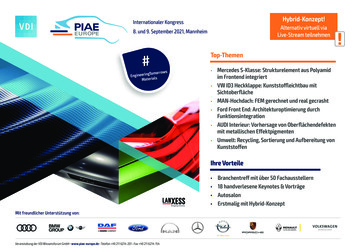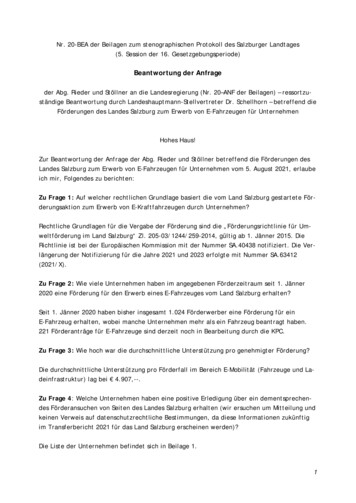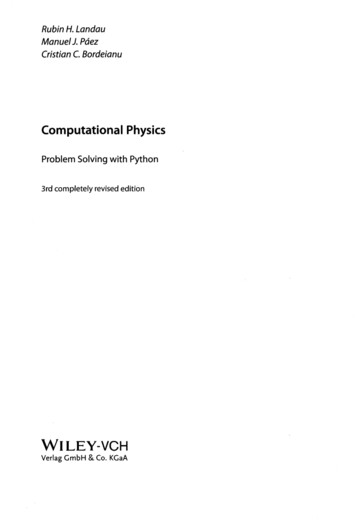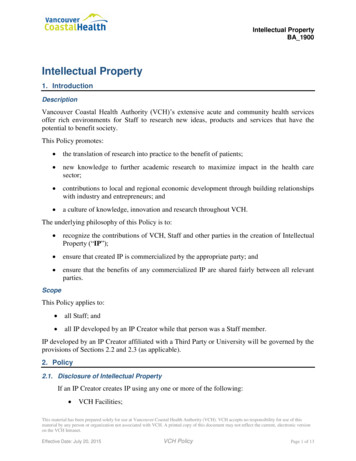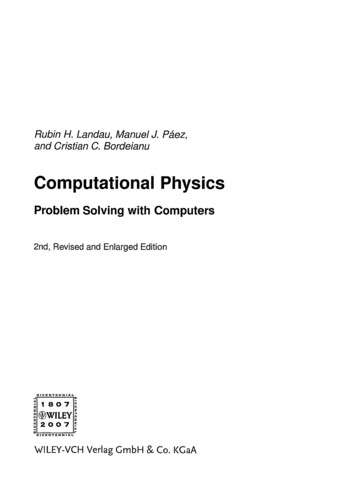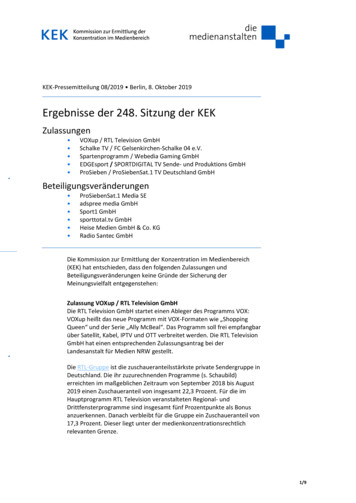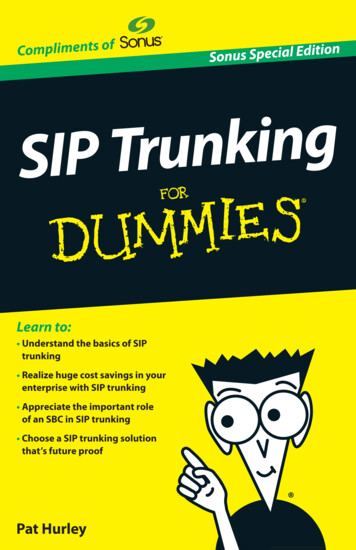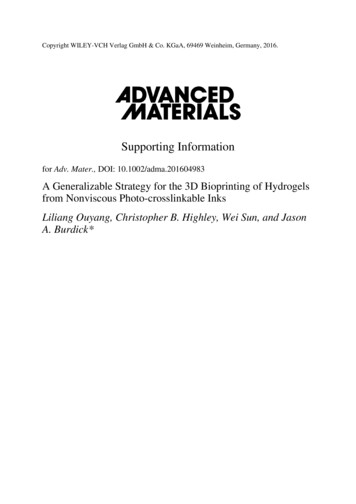
Transcription
Copyright WILEY-VCH Verlag GmbH & Co. KGaA, 69469 Weinheim, Germany, 2016.Supporting Informationfor Adv. Mater., DOI: 10.1002/adma.201604983A Generalizable Strategy for the 3D Bioprinting of Hydrogelsfrom Nonviscous Photo-crosslinkable InksLiliang Ouyang, Christopher B. Highley, Wei Sun, and JasonA. Burdick*
Submitted toSupporting informationA generalizable strategy for the 3D bioprinting of hydrogels from non-viscousphotocrosslinkable inksLiliang Ouyang, Christopher B. Highley, Wei Sun, and Jason A. Burdick**Corresponding author. Telephone: 215-898-8537; E-mail: burdick2@seas.upenn.eduMaterials synthesisSodium hyaluronate (HA, 75kDa) was purchased from Lifecore (Chaska, MN). Gelatin(type A, cat. G2500) and poly (ethylene glycol) diacrylate (PEGDA, 6kDa, cat. 701963) werepurchased from Sigma. Unless otherwise stated, all other chemicals were purchased fromSigma. Synthesized materials were dissolved in deuteroxide to acquire 1H-NMR spectra at360 MHz (Bruker).Methacrylated HA (MeHA). HA was converted to MeHA by esterification withmethacrylic anhydride (MA). 3 eq MA was added dropwise to aqueous 1 wt% HA solution onice, adjusting pH to 8 for 6-8 hours. After reacting overnight at 4 oC, another 3 eq MA wasadded to the reaction, followed by neutralization to pH 7-7.5. Modification of MeHA wasconfirmed with 1H-NMR as 26% (Figure S10A).Norbornene-functionalized HA (NorHA). Before NorHA synthesis, HA was firstconverted to its tetrabutylammonium salt (HA-TBA) to make it soluble in dimethyl sulfoxide(DMSO). HA-TBA was synthesized through adding Dowex 50W proton exchange resin to anaqueous 2 wt% HA solution (3g of resin per 1 g of HA) for a two-hour exchange reaction.The resin was removed by filtration and the filtrate was neutralized to pH 7.02-7.05 withTBA-OH (6 mL of TBA-OH per 1 g of HA). After freezing at -80 oC and lyophilization for 4days, HA-TBA was dissolved in DMSO together with 5-norbornene-2-carboxylic acid (NorCOOH; a mixture of endo and exo isomers) and 4-dimethylaminopyridine (DMAP).Approximately 20 mL DMSO per 0.1g HA-TBA was used, and reagents were dissolved at aratio of 3 eq Nor-COOH and 1.5 eq DMAP per 1 eq HA-TBA disaccharide repeat unit. Di-1
Submitted totert-butyl dicarbonate (BOC2O) was then added (0.4 eq) and the reaction solution heated to45 C. The reaction was allowed to proceed for 24 hours, followed by quenching with water,dialysis against water, precipitation against acetone (with 1 g NaCl added per 100 mL NorHAsolution), further dialysis, and lyophilization to yield a purified product. Modification ofNorHA was confirmed with 1H-NMR spectra as 22% (Figure S10C).Gelatin methacryloyl (GelMA). Gelatin methacrylate was prepared through theconjugation of methacrylic anhydride to gelatin as described previously[1]. Gelatin wasdissolved in phosphate buffered saline (PBS) at 60 C. Methacrylic anhydride was addeddropwise, and the mixture was stirred for three hours at 60 C. The reaction mixture wassubsequently dialyzed against water at 40 C for one week. GelMA was then frozen withliquid nitrogen and stored at -80 C until lyophilization and use. Modification of GelMA wasconfirmed with 1H-NMR as 50% (Figure S10B).Lithium phenyl-2, 4, 6-trimethylbenzoylphosphinate (LAP). LAP was synthesizedaccording to published methods[2]. Dimethyl phenylphosphate and 2,4,6-trimethylbenzoylchloride were combined at an equimolar ratio and stirred for 18 hours at room temperatureunder an inert atmosphere. A four-fold excess of lithium bromide in 2-butanone was thenadded and the mixture was heated to 50 C. A solid precipitate was formed, and the mixturewas cooled to room temperature. The precipitate was recovered by filtration and washed with2-butanone to remove unreacted lithium bromide. Excess solvent was removed by vacuum.The dry product was stored at -20 C until use.Peptide synthesis. Peptides used to fluorescently label MeHA (GCKK-fluorescein,GCKK-rhodamine) and to enable MMP-cleavable crosslinking of NorHA gels (GCNSGGRM SMPV-SNCG) were synthesized with thiols (cysteine residues), which added tomethacrylates in MeHA via Michael addition reactions or to norbornene residues in NorHAvia light-initiated thiol-ene chemistry. The italics in the MMP-cleavable sequence indicate theportion of the sequence susceptible to enzymatic cleavage, and the arrow indicates the2
cleavage site[3]Submitted to. Peptides were synthesized using solid-phase peptide synthesis (PS3automated peptide synthesizer, Protein Technologies, Inc.) off of a glycinol 2-chlorotritylresin (Novabiochem), using standard FMOC-chemistry. Sythesized peptides were cleaved,deprotected, dissolved in water, lyophilized, and stored at -20 C until use.Fluorescent labeling. MeHA was combined in a triethanolamine buffer (pH 10) with afluorescent peptide (either GCKK-fluorescein or GCKK-rhodamine), such that the molar ratioMeHA:fluor-peptide was approximately 1:2 (moles of full-length MeHA molecule:molesfluorescent peptide). The reaction proceeded at room temperature for 2 hours, after which thesolution was neutralized and then purified by dialysis and lyophilization to yield the finalproduct.Bioprinter and bioprinting processThe adapted 3D bioprinter was a commercially available machine that was modified forextrusion of materials from syringes. A customized printerhead unit with a holder forcommercial syringes was incorporated in the printer and was connected via a series gears tothe stepper motor used to drive filament extrusion[4]. To apply the in-situ-crosslinkingapproach introduced in this study, the core modification was the light-permeable needle,which can be generalized to other 3D bioprinters without changing the main hardwareframework.Here, normal straight stainless steel and PTFE dispensing needles (McMaster-Carr) wereused as basic needles. As an extended light-permeable part, a glass capillary (Kimble Chase)or silicone tubing (Scientific Commodities) 30 mm in length was inserted onto these needlesover the needle tip and were fixed against movement with superglue or a helical cover,respectively. To reduce the extrusion resistence, the glass capillary was perfused with a glasswater repellent (Rain-X) for 10 min as hydrophobic surface modification. The disposablesilicone tubing was used without modification.3
Submitted toFor good control of the filament deposition, the speeds of filament generation (nozzle movement (were matched.andwas determined by extrusion flux and capillarysize and could be measured as Figure S5 showed, whilewas an input parameter specifiedby the g-code printing commands. Normally, a velocity of 0.5 mm/s was used for printingfilaments of medium size ( 500 μm). The printing process can be altered through variationsof these parameters.For printing of tubes on a rotating rod,andwere determined by rod diameter (D),filament diameter (d) and angular velocity of rotor (ω) as indicated in Figure 2B. Two rods of5 mm and 1.5 mm in diameter were used to coil filaments of 500 μm and 200 μm indiameter, respectively. After deposition, the tube was treated with added initiator and UVirradiation (1 2min) for post-stabalization, followed by immersion in PBS.Co-axial printingA normal co-axial needle (Figure S3B, core: 23G, shell: 18G) was used to print core-shelland heterogenerous filaments. Core-shell filaments were generated when both channels wereopened, while heterogenerous filaments were generated when flows from the two channelswere alternately switched on and off. The ratio of the two inks in the core/shell or along thefilament could be tuned by extrusion flux or switch time, respectively. Basically, extrusionflux of 0.1-0.4 mL/hr, switch time of 3-10 s, and silicone tubing of 30 mm in length were used.A co-axial needle with a 10 mm longer core (Figure S3C, core: 24G, shell: 18G) was usedto print hollow filaments. Silicone tubing was applied such that its internal diameter matchedthe outer diameter of the shell needle, and the tubing was cut so its outlet was even with theoutlet of the core needle. Prior to the addition of tubing, the extended part of the core needlewas immersed in water repellent (Rain-X) for 10 min to reduce extrusion resistence (FigureS3D). Because of the core needle in the middle, a bifurcated light guide was connected to thelamp for equal light irradiation in order to maintain homogenerous crosslinking (Figure S1D).Typically, extrusion flux of 0.1-0.2 mL/hr was used.4
Submitted toRheological characterizationRheological measurements were performed at 25 C on an AR2000 rheometer (TAInstruments) using a cone-plate geometry (20 mm diameter, 59 min 42 s cone angle, and 27μm gap). To measure the initial viscosity of the formulations, continuous flow tests wereconducted with shear rates from 0.1-500 s-1. To measure the response of rheologicalproperties to photopolymerization, in situ polymerization was performed with UV or visiblelight for different formulations for 5-10 min via a light-curing stage during oscillatory timesweeps at a frequency 1 Hz and a strain 0.5%.Figure S1. Chemical structures and crosslinking of various bioink formulations. (A) MeHA,where methacrylates were added to HA at pH 8 on ice for 6-8 hours; (B) GelMA, wherereactive groups were added to gelatin at 60oC for 3 hours; (C) PEGDA, where commercialproduct was used; and (D) NorHA, where norbornenes were added to HA via HAtetrabutylammonium salt (HA-TBA) through reaction in DMSO in the presence of Boc2O for2 hours. (A-C) and (D) used radical chain-growth polymerizations and thiol-ene crosslinking,respectively. (D) For NorHA crosslinking, both UV light with I2959 initiator and visible lightwith LAP initiator were used. (E) NorHA formulation with non-degradable (DTT) anddegradable (MMP-degradable) crosslinkers and with RGD modification.5
Submitted toFigure S2. Illustration of pre-crosslinking approach. (A) Time sweeps of storage modulus(G’) and loss modulus (G’’) for 5 wt% MeHA treated with pre-UV-irradiation for 10, 20, and30 seconds. (B) Quantified cell viability and (C) microscopy images of printed filamentsusing 5 wt% MeHA with pre-UV-irradiation. UV intensity of 10mW/cm2 was used. Scale baris 500 μm.Figure S3. Set-up of printer and nozzle systems. (A) Set-up of 3D bioprinter with curing lightunit and CAD/controller (left), where the light was introduced to the light-permeable capillaryof the nozzle (right). (B) Co-axial nozzle with the same length for core and shell needles. (C)Co-axial nozzle with 10 mm longer core needle. (D) Set-up for fabricating hollow filamentsusing nozzle in (C), where the light-permeable capillary was matched to cover the longer partof the core needle, leaving a shell space between the core needle and light-permeable capillary.A bifurcated light guide was used to shine light on both sides of the photopermeable capillaryfor homogeneous irradiation. Scale bars are 5 mm.6
Submitted toFigure S4. Demonstration of glass capillary for printing. (A) Extrusion status and (B) drivingforce for printing 5 wt% MeHA using a glass capillary with or without hydrophobicmodification. (A) The bioink was finally blocked in an unmodified capillary, while a hydrogelfilament was generated with modified capillary. (B) The time point when UV irradiation(10mW/cm2) was applied was indicated as arrow shown. Scale bar is 5 mm.Figure S5. Demonstration of consistent filament generation under 10 mW/cm2 UV irradiation.(A) Images of 5 wt% MeHA filaments during printing process indicate the continuousgeneration of filaments with time. (B) Relationship of filament displacement and printing timewith linear fitting, indicating a stable filament printing speed. Medium silicone tubing andextrusion flux of 0.2 mL/hr was used. Scale bar is 2 mm.7
Submitted toFigure S6. (A) Rheological profiles during the polymerization of MeHA bioinks with variedconcentrations and UV light intensities. The low MeHA concentration of 0.5 wt% did notundergo gelation. (B) Quantification of time to reach a plateau storage modulus (G’) forvarious MeHA concentrations and UV light intensities. (C) Lattice structures were printedunder different UV intensities with 1 wt% MeHA and visualized before and after beingimmersed in PBS. Filaments with 5 mW/cm2 were not polymerized well; however, coadhesion was observed as indicated (circle) with 10 and 15 mW/cm2, but did not occur(arrow) with more than 20 mW/cm2. Scale bars are 500 μm.Figure S7. (A) Fluorescence images of printed filaments and (B) driving force consistencywith varied UV intensity. (C) Microscopy images and (D) quantified diameter of printedfilaments using a photopermeable capillary of varied size (with UV intensity of 10 mW/cm2).5 wt% MeHA was used. Scale bars are 500 μm.8
Submitted toFigure S8. Images of printed nose at different time points of incubation in PBS at roomtemperature after fabrication. 5 wt% MeHA was used. Scale bar is 5 mm.Figure S9. Cell viability study at day 0. (A) Live/dead stained images of cell-laden filamentsprinted at different time points within 40 min (equal time interval for samples). (B)Normalized cell density and (C) quantified cell viability for different samples based on (A).(D) Live/dead stained images of smaller and larger cell-laden filaments. (E) Quantified cellviability for filaments with three different sizes. Cell viability was also measured for printed(F) lattice structures and (G) a macro nose structure. (A-E) used 5 wt% MeHA, (F-G) used 2.5wt% MeHA, and a UV intensity of 10mW/cm2 was used. Scale bars are 500 μm.9
Submitted toFigure S10. 1H-NMR spectrum of synthesized macromers with proton peaks highlighted fordetermining (A) methacrylate modification in MeHA, (B) methacrylamide modification inGelMA, and (C) norbornene modification in NorHA.Figure S11. Rheological profiles during the polymerization of bioinks with UV or visible light.(A-D, F) used 0.05% I2959 and 10 mW/cm2 UV light. (E) used 0.05% LAP and 15 mW/cm2visible light. (D-E) used XDTT 0.6. (F) used XMMP-deg 0.6. Shaded area indicated the lightirradiation duration. Details about the formulations are indicated in Table S1.10
Submitted toFigure S12. Driving force for printing different ink formulations: 2.5 wt% MeHA, 5 wt%GelMA, 5 wt% PEGDA and 2 wt% NorHA (DTT I2959).Figure S13. Fluorescence signal intensity profiles along white dot arrow for (A) core-shell,(B) heterogeneous, and (C) hollow filaments.Table S1. Details of formulations and their initial ightInitial viscosity(mPa s)MeHA-5%5 wt%MeHA0.05% I2959//0-20mW/cm2UV73.4 1.1MeHA-2.5%2.5 wt%MeHA0.05% I2959//10mW/cm2UV15.1 0.3GelMA5 wt%GelMA0.05% I2959//10mW/cm2UV5.1 0.7PEGDA5 wt%PEGDA0.05% I2959//10mW/cm2UV2.5 0.6NorHA (DTT I2959)2 wt%NorHA0.05% I2959XDTT 0.6/10mW/cm2UV9.9 0.5NorHA (DTT LAP)2 wt%NorHA0.05% LAPXDTT 0.6/15mW/cm2visible9.3 0.3NorHA(DTT I2959 RGD)2 wt%NorHA0.05% I2959XDTT 0.63mM10mW/cm2UV8.9 0.6NorHA (MMPdeg I2959 RGD)2 wt%NorHA0.05% I2959XMMP-deg 0.63mM10mW/cm2UV9.9 0.7Note: The initial viscosity was obtained under shear rate of 10 s-1.11
Submitted toMovie S1. Injection of 5 wt% MeHA using: i) pre-crosslinking, where inks came out as anirregular filament with obvious fracture; ii) post-crosslinking, where inks came out drop-bydrop; and iii) in-situ-crosslinking, where inks formed a regular filament continuously. PreUV-irradiation of 30 seconds was applied in pre-crosslinking, while UV light wascontinuously shined under the needle or at the light-permeable capillary for post-crosslinkingor in-situ-crosslinking, respectively.Movie S2. Snapshots of printing of line structure and a hollow tube structure. In the end of themovie, PBS was added to the hollow tube to test the structure stability. 5 wt% MeHA wasused.12
Submitted toMovie S3. Video of filament deposition on a rotating rod for fabricating hollow tubestructures. 2.5 wt% MeHA was used. Video was 12 times faster than realtime.Movie S4. Cell fluorescence images for different formulations from bottom to top with a zstack confocal scanning of cell-laden filaments. Cell morphology was clearly observedthroughout the filament, including the inner and near-surface parts. The details of theseformulations were indicated in Table S1.Movie S5. Perfusion of a printed hollow filament, which was printed using a co-axial needlewith a longer inner needle (Figure S3C-D). Green dye was perfused through the filamentsmoothly, which demonstrated the open channel along the filament and closed radial shell. 2.5wt% NorHA with DTT crosslinker was used.13
Submitted toSupplementary References[1] A. I. Van Den Bulcke, B. Bogdanov, N. De Rooze, E. H. Schacht, M. Cornelissen, H.Berghmans, Biomacromolecules 2000, 1, 31.[2] B. D. Fairbanks, M. P. Schwartz, A. E. Halevi, C. R. Nuttelman, C. N. Bowman, K. S.Anseth, Adv Mater 2009, 21, 5005.[3] R. J. Wade, E. J. Bassin, C. B. Rodell, J. A. Burdick, Nat Commun 2015, 6, 6639.[4] C. B. Highley, C. B. Rodell, J. A. Burdick, Adv Mater 2015, 27, 5075.14
Rheological measurements were performed at 25 C on an AR2000 rheometer (TA Instruments) using a cone-plate geometry (20 mm diameter, 59 min 42 s cone angle, and 27 μm gap). To measure the initial viscosity of the formulations, continuous flow tests were conducted with shear rates from 0.1-500 s-1. To measure the response of rheological
